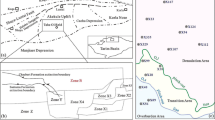The distribution of fractures and its dependence on lithology and petrophysical properties of rock in the Asmari Formation were examined using three wells data of one of the largest oil fields of southwestern Iran. Fractures were measured on cut cores. Mineral content and petrophysical data were obtained through thin section study and core plug measurement respectively. Influence of mineral composition and petrophysical property of rocks on fracture density was explored statistically. Increasing quartz (sand) and anhydrite content of rocks decrease and dolomite increases the threshold of fracture densities, however no significant relation was observed between calcite content of rock and fracture density. Increasing porosity and permeability of rock decrease the threshold of fracture density in some of the defined lithology groups. There are significant differences between the lithology groups in terms of fracture density, although the results in the three wells are not the same. In whole data, the highest fracture density can be observed in dolostone. Limestone and impure carbonates hold broader spaced fractures and sandstones display the least fracture density. The average fracture densities in the wells are strictly different. These differences are the result of the structural position of the wells and also the trend of the well and fractures. The distribution of fractures in most lithology groups can be explained by the function: \(F = a/(1 + b\;D\exp (c))\), where F is relative frequency, D is fracture density and a, b, and c are constants.








Similar content being viewed by others
REFERENCES
Bai, T., and Pollard, D. D., 2000, Fracture spacing in layered rocks: a new explanation based on stress transition: Jour. Struc. Geolgy., v. 22, no. 1, p. 43–57.
Berberian, M., 1995, Master “blind” faults hidden under the Zagros folds: active basement tectonics and surface morphotectonics: Tectonophysics, v. 241, no. 3–4, p. 193–224.
Bourne, S. J., Bauckmann, F., Rijkels, L., Stephenson, B. J., Weber, A., and Willemse, E. J. M., 2000, Predictive modeling of naturally fractured reservoirs using geomechanism and flow simulation: 9th Abu Dhabi Intern Petroleum Exhibition and Conference (Abu Dhabi, UAE) 10 p.
Colman-Saad, S. P., 1978, Fold development in Zagros simply folded belt, southwest Iran: Am. Assoc. Petrolium Geologists Bull., v. 62, no. 6, p. 984–1003.
Dershowitz, W. S., and Herda, H. H., 1992, Interpretation of fracture spacing and intensity, in Tillerson, J. R., and Wawersik, W. R., eds., Proc. 33rd U.S. Symp. Rock Mechanics: Balkema, Rotterdam, p. 757–766.
Dunn, D. E., LaFountain, L. J., and Jackson, R. E., 1973, Porosity dependence and mechanism of brittle fracture in sandstone: Jour. Geol. Research., v. 78, no. 14, p. 2403–2416.
Falcon, N. L., 1969, Problems of the relationship between surface structure and deep displacement illustrated by the Zagros Range, in Satterthwaite, G. E., and Spencer, A. M., eds., Time and place in orogeny. Geol. Soc., Spec. Publ., v. 3, p. 9–22.
Hallsworth, C. R., and Knox, R. W. O'B., 1999, BGS rock classification scheme, volume 3, classification of sediments and sedimentary rocks: British. Geol. Surver., Res. Rept. RR 99-03, 44 p.
Hobbs, D. W., 1967, The formation of tension joints in sedimentary rocks: an explanation: Geol. Magazine., v. 104, no. 6, p. 550–556.
Mauldon, M., and Dershowitz, W. S., 2000, A multi-dimensional system of fracture abundance measure (abst.): Geol. Soc. America Abstract and Programs, v. 32, p. A474.
McQuillan, H., 1973, Small-scale fracture density in Asmari Formation of southwest Iran and its relation to bed thickness and structural setting: Am. Assoc. Petroleum Geologists Bull., v. 57, no. 12, p. 2367–2385.
Murray, G. H., Jr., 1968, Quantitative fracture study, Sanish Pool, McKenzie Co., North Dakota: Am. Assoc. Petroleum Geologists Bull., v. 52, no. 1, p. 57–65.
Narr, W., and Lerche, I., 1984, A method for estimating subsurface fracture density in core: Am. Assoc. Petroleum Geologists Bull., v. 68, no. 5, p. 637–648.
Narr, W., and Suppe, J., 1991, Joint spacing in sedimentary rocks: Jour. Struc. Geology., v. 13, no. 9, p. 1037–1048.
Nelson, R. A., 2001, Geologic analysis of naturally fractured reservoirs: Gulf Prof. Pub., Houston, TX, 332 p.
Price, N. J., 1966, Fault and joint development in brittle and semi-brittle rocks: Pergamon, Oxford, 176 p.
Price, N. J., and Cosgrove, J. W., 1990, Analysis of geological structures: Cambridge Univ. Press, Cambridge, 502 p.
Ramsay, J. G., and Huber, M. I., 1987, The techniques of modern structural geology, v. 2: folds and fractures: Academic Press, London, 392 p.
Sattarzadeh, Y., Cosgrove, J. W., and Vita-Finzi, C., 2000, The interplay of faulting and folding during the evolution of the Zagros deformation belt, in Cosgrone, J. W., and Ameen, M. S., eds., Forced folding and fractures: Geol. Soc. Spec. Publ., v. 169, p. 187–196.
Sowers, G. M., 1973, Theory of spacing of extension fractures: Eng. Geol. Case Histories, v. 9, p. 27–53.
Stearns, T. W., 1968, Certain aspects of fracture in naturally deformed rocks, in Riekter, R. E., ed., NSF Advanced science seminar in rock mechanics: Air Force Cambridge Research Laboratories, Bedford, Massachusetts, AD 6693751, p. 97–118.
Stocklin, J., 1968, Structural history and tectonics of Iran: a review: Am. Assoc. Petroleum Geologists Bull., v. 52, no. 7, p. 1229–1258.
Tucker, M. E., 1988, Techniques in sedimentology: Blackwell Sci. Pub., Oxford, 394 p.
ACKNOWLEDGMENTS
Part of core fracture study was carried out by M. Azizzadeh, (RIPI), C. Von Winterfeld (Statoil, now in Shell Oman), K. B. Lyslo (Statoil), and petrographic data prepared by Honarmand, J. Z. Karimi, and S. Monibi. Data treatment and depth normalization carried out by A. A. Rahimibahar. We are grateful to them for their help and cooperation. We also acknowledge the help of Ali Vakili, the president of RIPI and M. R. Kamali, head of “E and P Research and Studies Division” by providing us with the data.
Author information
Authors and Affiliations
Corresponding author
Rights and permissions
About this article
Cite this article
Nemati, M., Pezeshk, H. Spatial Distribution of Fractures in the Asmari Formation of Iran in Subsurface Environment: Effect of Lithology and Petrophysical Properties. Nat Resour Res 14, 305–316 (2005). https://doi.org/10.1007/s11053-006-9000-y
Received:
Accepted:
Published:
Issue Date:
DOI: https://doi.org/10.1007/s11053-006-9000-y




